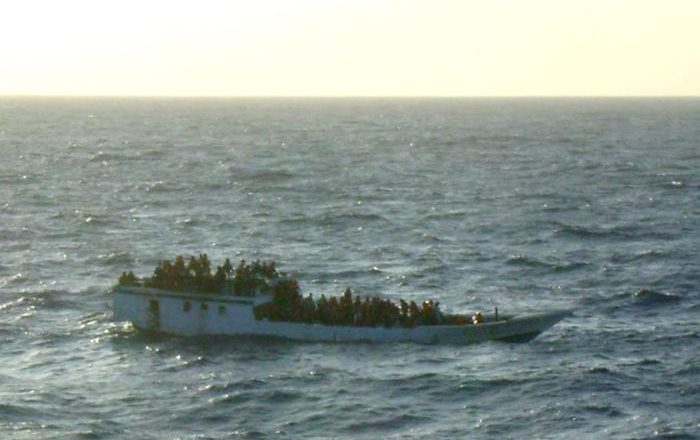
By Jessica Szwarcbord
In our second review of human rights in the media we look at Victoria’s new trial plan on how to deal with “aggressive beggars”, asylum seekers arriving in numbers more than double this time last year, and rock art at risk in the face of uranium mining.
A new trial by the Melbourne City Council to target “aggressive” begging: crackdown or cure?
Inher well-written opinion article, published by The Age on 2 March 2013, Melbourne Journalist Suzy Freeman-Greene asked “Why is it a crime to beg when charity touts can ask us for money on the streets?” She referred to the Summary Offences Act 1966 (Vic), section 49A, which prohibits “begging or gathering alms”. The penalty under the act is 12 months imprisonment. She pointed out that while police “often turn a blind eye to this crime” and will “refer beggars to agencies for help”, the Magistrates Court still heard 393 begging related cases between 2009-2011.
The Herald Sun then published “I have a plan to deal with the scourge of our streets,” by Melbourne City Lord Mayor Robert Doyle, on 10 March, in which he advised us never to give money to beggars. He highlighted that for non-aggressive beggars there would be diversion programs but that we need to deal with the increase in “aggressive begging” using the police and the courts.
The Herald Sun explained the plan as a “crackdown aimed at revitalising city streets”, discussing the proposed benefits from Doyle’s perspective, on the same day that they published his article. They also published another article in which David, who is forced to beg in Melbourne due to his inadequate disability pension, challenged Doyle to “live a day in his shoes”.
The following day, ABC News 24 showed Doyle speaking further on the issue, saying that he did not want to ban begging, but instead intended the begging laws to help beggars. He said that he aimed to lessen the amount of beggars on the streets and wanted cooperation between support services and police, with beggars picked up by police to be referred to support services.
Although Doyle referred to anecdotal evidence that there was an increase in violence, the ABC pointed out there is no concrete evidence of a peak in aggression and no evidence of a crisis. The ABC explained that the increase in begging could be due to an increase in homelessness. Carolyn Atkins of the Victorian Council of Social Services said that “VCOSS has not heard from its members that there is an urgency, that there is a need to crack down [on aggressive begging]”.
ABC Radio then covered the issue, establishing that Doyle denied that the initiative was a “crackdown”. The Salvation Army’s Brendan Nottle then interviewed discussed two types of beggars, the first being organised and aggressive and needing to be dealt with by the police and courts. He described the plan as “innovative”, unique to Victoria, and designed to connect with the most vulnerable in the city. James Farrell, a law lecturer at Deakin University, said that he did not think that using anti-begging laws was the best way to help those who are most vulnerable. Instead, he held a similar opinion to Freeman-Greene, suggesting de-criminalisation.
A day after publishing Doyle, the Herald Sun published an article expressing concerns that this misguided approach would increase crime: “the move has prompted outrage among Victoria’s poorest residents, who fear they will be forced into a life of crime.”
The Courier expressed the hope that the City of Melbourne’s plan to deal with beggars would be successful in targeting aggressive professional beggars, who are a problem, rather than those who “have fallen on tough times and have to resort to living on the streets.”
The day after, on 12 March, The Age published an article online about Councillor Richard Foster’s disapproval of the plan, who described it as “an example of Liberal Party class warfare”. They also published an article from Doyle’s perspective, explaining his justification for the plan, and pointing out that it was a trial. In the print edition of The Age on the same day a small mention of the ‘co-ordinated plan’ was made on page thirteen, also noting it is a trial, and quoting only Doyle and citing only the proposed benefits of the plan.
Overall, the coverage did present both sides of the debate, although the voice of some media outlets were silent. It was a short-lived but heated debate, peaking over three days and then subsiding just as quickly as it came about.
Asylum Seekers – a large presence in the media this month
When it comes to asylum seekers the media coverage is vast. I have limited my focus to the last week of March, which had a startling amount of arrivals or attempted arrivals.
On 28 March 147 asylum seekers were on board a boat southwest of Darwin. According to The Western Australian, Senator Trish Crossin believes that asylum seekers are “trying to take advantage” of the legislative loophole that requires onshore processing when asylum seekers arrive on the mainland, but offshore processing when they arrive at Christmas Island.
On the same day Nine News ran a story about a hunger strike on Manus Island and The Age ran a story on page eleven about the expectation that 400 more asylum seekers would arrive by the end of the week. The article pointed out the stress on Christmas Island’s resources and the fact that the amount of arrivals from the beginning of 2012, by this time last year, was less than half of the number that we have had so far this year.
On 27 March The Australian and news.com.au reported that Sri Lanka’s navy intercepted a fishing trawler. On board were 97 Sri Lankan Tamil asylum seekers heading for Australia. The majority on board were children and all were handed over to the Sri Lankan police. The Australian highlighted that “thousands have died making the treacherous journey” to Australia and that our detention centres are at their limits. On the same day The Age reported on page 9 that the day before “two boatloads of asylum seekers were brought to shore on Christmas Island”, totalling 188 people According to the article, from the beginning of 2013 to 27 March, 3111 asylum seekers had made the journey to Australia.
On 25 March a child and a young woman drowned after a fishing boat carrying asylum seekers overturned, throwing 95 passengers (the deceased included) into the waves. According to ABC News, Prime Minister Julia Gillard’s response was one of sorrow, but also chastisement. She told Channel Ten, “[M]y message is a very clear one: do not pay a people smuggler, do not get on a boat.”
The Age covered this story on the front page under the headline, Asylum seekers drown while officials on board, on 26 March, noting that the Home Affairs Minister Jason Clare had affirmed that authorities had spotted the boat on the afternoon before it sunk in the early morning of the next day, but they had not noticed any signs of distress. The same article cited Senator Hanson-Young, who said that “the ‘punitive’ measures adopted on August 13 last year, including sending asylum seekers to Nauru and Papua New Guinea’s Manus Island, were not deterring individuals.”
In an editorial, The Age also expressed frustration that the “figures demonstrate that the repeated threats by successive governments to crack down on the wretched trade are not having any impact.” Meanwhile, on the same day, The Australian published an article titled “Howard asylum-seeker tactics worked, says people-smuggler Sayed Abbas”, including an interview with a people-smuggler who commented that turning the boats around does work.
ABC News and ANC radio covered the story too, focusing on the fact that two customs officers had just boarded the boat when it capsized.
With the large increase in arrivals the news coverage has been constant, however, despite the almost daily coverage, there has been little in-depth reporting. One article that bucked the trend was Ben Doherty’s, “Escape at any cost: Hazaras put their lives on the line for Australian dream”, published in The Age on 30 March.He argues that Hazaras, an ethnic minority within Afghanistan, will accept any risk to escape to Australia, as their choice is between possible death on the seas or certain death at home.
Rock Art threatened by Australian mining prospects
On 2 March The Australian reported that mining exploration may threaten some of Australia’s oldest rock art on Cape York. While listed by UNESCO as one of the top ten rock art sites in the world, the article points out that the rock art is not listed on the National Heritage List and the area has not been determined under native title. Hancock Prospecting’s subsidiary Jacaranda Minerals is seeking the exploration licence. Environment Minister Tony Burke was reportedly sympathetic to the issue, pledging his support to the request that the rock art be heritage listed. The article also quotes a spokeswoman of Jacaranda who assures that the company will have the rock art in mind when and if they do explore the area.
On 8 March The Global Mail published an in-depth article on the rock art in both the ‘Quinkan’ area, where Jacaranda wishes to explore, and in the Wellington Range, Arnhem Land, where Canadian Cameco wishes to mine uranium. The article points out that if the federal Coalition are elected in September, the rock art will be more at risk, due to the pro-industrial expansion policy highlighted in their draft discussion paper. Even heritage listings may not be enough protection, if more are successfully sought.
On the same day in the UK The Guardian referred to The Global Mail article, focusing on the Canadian mining company Cameco, but not Jacaranda, noting that the current Australian government’s stance on uranium mining has “softened”. Cameco is looking to mine uranium deposits in the Wellington Range area, which also contains precious rock art.
The Australian published another article about the rock art, coinciding with The Global Mail’s and The Guardian’s, expressing doubt about whether the company will protect the rock art during exploration, despite their assurances. They highlight that the vast landscape in which the rock art is widely dispersed means that ensuring its protection during exploration is practically impossible.
Further media coverage is difficult to find. It seems that this issue is as hidden as the rock art itself, despite the permanent possible repercussions for the cultural rights and property rights of the traditional landowners.


